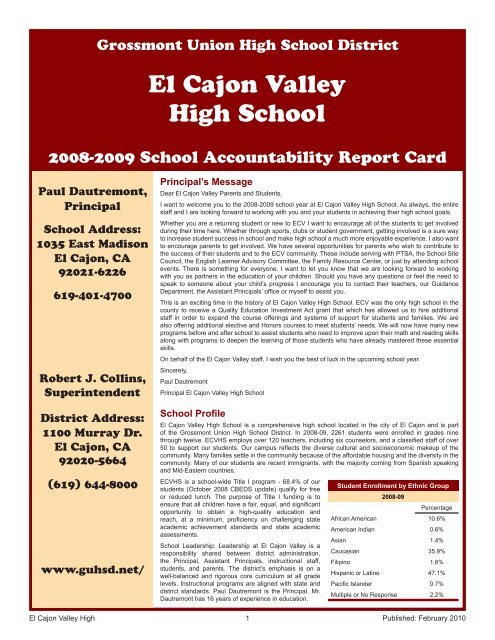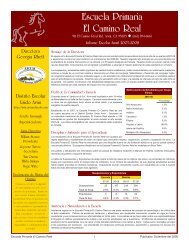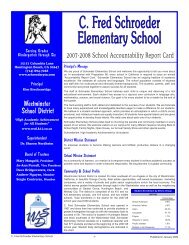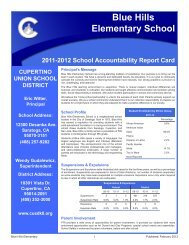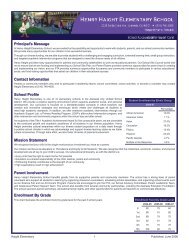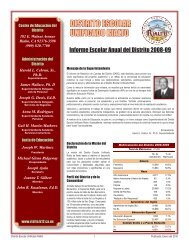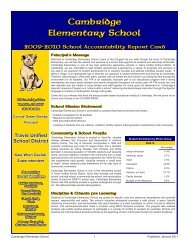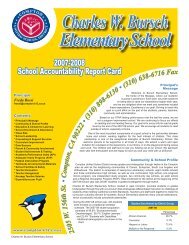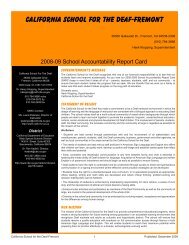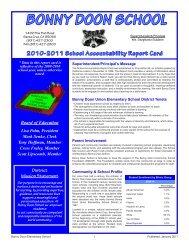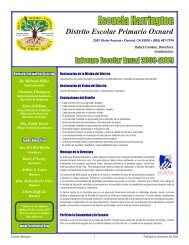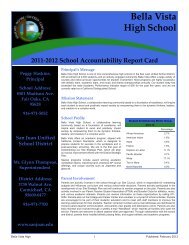El Cajon Valley High School - Axiomadvisors.net
El Cajon Valley High School - Axiomadvisors.net
El Cajon Valley High School - Axiomadvisors.net
You also want an ePaper? Increase the reach of your titles
YUMPU automatically turns print PDFs into web optimized ePapers that Google loves.
Grossmont Union <strong>High</strong> <strong>School</strong> District<br />
<strong>El</strong> <strong>Cajon</strong> <strong>Valley</strong><br />
<strong>High</strong> <strong>School</strong><br />
2008-2009 <strong>School</strong> Accountability Report Card<br />
Paul Dautremont,<br />
Principal<br />
<strong>School</strong> Address:<br />
1035 East Madison<br />
<strong>El</strong> <strong>Cajon</strong>, CA<br />
92021-6226<br />
619-401-4700<br />
Robert J. Collins,<br />
Superintendent<br />
District Address:<br />
1100 Murray Dr.<br />
<strong>El</strong> <strong>Cajon</strong>, CA<br />
92020-5664<br />
(619) 644-8000<br />
www.guhsd.<strong>net</strong>/<br />
Principal’s Message<br />
Dear <strong>El</strong> <strong>Cajon</strong> <strong>Valley</strong> Parents and Students,<br />
I want to welcome you to the 2008-2009 school year at <strong>El</strong> <strong>Cajon</strong> <strong>Valley</strong> <strong>High</strong> <strong>School</strong>. As always, the entire<br />
staff and I are looking forward to working with you and your students in achieving their high school goals.<br />
Whether you are a returning student or new to ECV I want to encourage all of the students to get involved<br />
during their time here. Whether through sports, clubs or student government, getting involved is a sure way<br />
to increase student success in school and make high school a much more enjoyable experience. I also want<br />
to encourage parents to get involved. We have several opportunities for parents who wish to contribute to<br />
the success of their students and to the ECV community. These include serving with PTSA, the <strong>School</strong> Site<br />
Council, the English Learner Advisory Committee, the Family Resource Center, or just by attending school<br />
events. There is something for everyone. I want to let you know that we are looking forward to working<br />
with you as partners in the education of your children. Should you have any questions or feel the need to<br />
speak to someone about your child’s progress I encourage you to contact their teachers, our Guidance<br />
Department, the Assistant Principals’ office or myself to assist you.<br />
This is an exciting time in the history of <strong>El</strong> <strong>Cajon</strong> <strong>Valley</strong> <strong>High</strong> <strong>School</strong>. ECV was the only high school in the<br />
county to receive a Quality Education Investment Act grant that which has allowed us to hire additional<br />
staff in order to expand the course offerings and systems of support for students and families. We are<br />
also offering additional elective and Honors courses to meet students’ needs. We will now have many new<br />
programs before and after school to assist students who need to improve upon their math and reading skills<br />
along with programs to deepen the learning of those students who have already mastered these essential<br />
skills.<br />
On behalf of the <strong>El</strong> <strong>Cajon</strong> <strong>Valley</strong> staff, I wish you the best of luck in the upcoming school year.<br />
Sincerely,<br />
Paul Dautremont<br />
Principal <strong>El</strong> <strong>Cajon</strong> <strong>Valley</strong> <strong>High</strong> <strong>School</strong><br />
<strong>School</strong> Profile<br />
<strong>El</strong> <strong>Cajon</strong> <strong>Valley</strong> <strong>High</strong> <strong>School</strong> is a comprehensive high school located in the city of <strong>El</strong> <strong>Cajon</strong> and is part<br />
of the Grossmont Union <strong>High</strong> <strong>School</strong> District. In 2008-09, 2261 students were enrolled in grades nine<br />
through twelve. ECVHS employs over 120 teachers, including six counselors, and a classified staff of over<br />
50 to support our students. Our campus reflects the diverse cultural and socioeconomic makeup of the<br />
community. Many families settle in the community because of the affordable housing and the diversity in the<br />
community. Many of our students are recent immigrants, with the majority coming from Spanish speaking<br />
and Mid-Eastern countries.<br />
ECVHS is a school-wide Title I program - 68.4% of our<br />
students (October 2008 CBEDS update) qualify for free<br />
or reduced lunch. The purpose of Title I funding is to<br />
ensure that all children have a fair, equal, and significant<br />
opportunity to obtain a high-quality education and<br />
reach, at a minimum, proficiency on challenging state<br />
academic achievement standards and state academic<br />
assessments.<br />
<strong>School</strong> Leadership: Leadership at <strong>El</strong> <strong>Cajon</strong> <strong>Valley</strong> is a<br />
responsibility shared between district administration,<br />
the Principal, Assistant Principals, instructional staff,<br />
students, and parents. The district’s emphasis is on a<br />
well-balanced and rigorous core curriculum at all grade<br />
levels. Instructional programs are aligned with state and<br />
district standards. Paul Dautremont is the Principal. Mr.<br />
Dautremont has 16 years of experience in education.<br />
Student Enrollment by Ethnic Group<br />
2008-09<br />
Percentage<br />
African American 10.6%<br />
American Indian 0.6%<br />
Asian 1.4%<br />
Caucasian 35.9%<br />
Filipino 1.6%<br />
Hispanic or Latino 47.1%<br />
Pacific Islander 0.7%<br />
Multiple or No Response 2.2%<br />
<strong>El</strong> <strong>Cajon</strong> <strong>Valley</strong> <strong>High</strong> 1<br />
Published: February 2010
He has held positions as a teacher and Assistant Principal prior to<br />
becoming <strong>El</strong> <strong>Cajon</strong> <strong>Valley</strong> <strong>High</strong> <strong>School</strong>’s Principal.<br />
Staff members and parents participate on various committees that make<br />
decisions regarding the priorities and direction of the educational plan to<br />
ensure instructional programs are consistent with students’ needs and<br />
comply with district goals. Leadership teams include:<br />
• Administrative team<br />
• Navigation Team<br />
• Department Chairs<br />
• Program Coordinators<br />
• Academy Leads<br />
• Professional Learning Community Team Leads<br />
• <strong>School</strong> Site Council<br />
• Parent Teacher Student Association (PTSA)<br />
• English Learners Advisory Committee (ELAC)<br />
• Associated Student Body (ASB)<br />
• Student Senate<br />
• Class Officers<br />
Curriculum and Instruction - The Base of the Pyramid of Interventions<br />
Professional Learning Communities: All teachers are highly qualified<br />
and teach a rigorous, relevant curriculum within their area of expertise.<br />
Teachers work in teams of Professional Learning Communities to address<br />
four critical questions:<br />
• What do students need to learn?<br />
• How will we know when students have learned?<br />
• How will we respond when students experience difficulty in learning?<br />
• How will we provide enriching experiences to students who have<br />
already mastered essential knowledge and skills?<br />
Curriculum is focused on California Content Standards using researchbased<br />
teaching strategies. Classes are arranged on a traditional calendar<br />
with a 4X4 block quarter schedule. In this setting, students are able to meet<br />
graduation, college preparatory, and Advanced Placement requirements.<br />
Advanced Placement courses are offered in the areas of Art, English,<br />
Foreign Language, Math and Social Sciences. <strong>El</strong> <strong>Cajon</strong> <strong>Valley</strong> <strong>High</strong> <strong>School</strong><br />
is a national demonstration site for AVID (college preparation). Extra- and<br />
Co-curricular activities are available. An extensive after-school program<br />
includes classes for academic support as well as for personal enrichment.<br />
Quality Education Investment Act (QEIA) at ECVHS:<br />
In May of 2007, <strong>El</strong> <strong>Cajon</strong> <strong>Valley</strong> <strong>High</strong> <strong>School</strong> received a multi-year grant (up<br />
to seven years) to improve student achievement and provide the needed<br />
supports. ECVHS will focus all efforts around the goal of improving student<br />
achievement through the implementation of the tiered intervention model<br />
with the work of the Professional Learning Communities as the foundation.<br />
This model will be based on:<br />
QUALITY INSTRUCTION/ FIRST TEACHING<br />
• Implementation of the Professional Learning Community Model of<br />
teacher teams school-wide, in all subject areas.<br />
• Standards-based engaging curriculum with ongoing assessment and<br />
monitoring that focuses on Rigor/Relevance/Relationships<br />
STAFF DEVELOPMENT<br />
• PLC coaches to assist with the implementation of the PLC model<br />
• <strong>School</strong>-wide staff development to address staff, student and family<br />
engagement in the educational process<br />
ACADEMIC SUPPORT AND INTERVENTIONS<br />
• Strategic, data-driven, with clear entrance and exit criteria to include all<br />
students (regular, special education, and English Learners) who have<br />
been identified as needing extra support<br />
SOCIAL-EMOTIONAL SUPPORT<br />
• Family Resource Center (FRC)/Case-Management Referral Process -<br />
Integrated and coordinated system of supports for students and families<br />
that focuses on improving student achievement<br />
ASSESSMENT AND MONITORING SYSTEM<br />
• Design and implementation to include frequent diagnostic tests as well<br />
as annual standardized assessments<br />
• Designed with input from staff, students and families to address their<br />
needs for data collection and reporting<br />
COLLABORATION/ENGAGEMENT<br />
• Focused on improving communication with-in and between the:<br />
Professional Learning Community teams; students, parents and staff;<br />
community partners, and post-secondary education partners<br />
For more details, please see the QEIA website: http://www.cde.ca.gov/nr/<br />
ne/yr07/yr07rel62.asp<br />
Discipline & Climate for Learning<br />
Discipline and Climate for Learning – SARC 08-09<br />
Discipline and Climate for Learning<br />
Students at <strong>El</strong> <strong>Cajon</strong> <strong>Valley</strong> are guided by specific rules and classroom<br />
expectations that promote respect, cooperation, courtesy and acceptance<br />
of others. Parents and students are informed of school rules and discipline<br />
policies through the Student Handbook which is sent home at the beginning<br />
of the school year.<br />
Students are encouraged to participate in the school’s additional academic<br />
and extracurricular activities, which are an integral part of the educational<br />
program. These schoolwide and classroom incentives promote positive<br />
attitudes, encourage achievement, and aid in the prevention of behavioral<br />
problems. Extracurricular activities, clubs, and programs include:<br />
• Club Cristiano • Class of 2009, 2010, 2011, 2012<br />
• Outdoor Adventure Club • Shakespeare<br />
• Art Club<br />
• Filipino Student Association<br />
• Academic League<br />
• Marching Band<br />
• Leo’s Club<br />
• Friday Night Live<br />
• Smoke Signal<br />
• Pep Club<br />
• Link Crew<br />
• German Club<br />
• The Green Team<br />
• ECV Players<br />
• AVID<br />
• Legend<br />
• Key Club<br />
• Christian Club<br />
• CARE Club<br />
The school’s interscholastic athletic programs promote individual and teamoriented<br />
achievement and self-esteem through school-sponsored teams<br />
that compete with other schools in the area. Athletic programs include:<br />
Fall Sports - August-November<br />
Boys and Girls Cross Country, Football, Girls Tennis, Girls Volleyball, Boys<br />
Water Polo, Girls Field Hockey<br />
Winter Sports - November-February<br />
Boys and Girls Basketball, Boys and Girls Soccer, Wrestling, Girls Water<br />
Polo<br />
Spring Sports - February-May<br />
Baseball, Golf, Gymnastics, Softball, Boys and Girls Swimming, Boys<br />
Tennis, Boys and Girls Track & Field, Boys Volleyball<br />
The Cheer Squad season runs all year long.<br />
Enrollment By Grade<br />
This chart illustrates the<br />
enrollment trend by grade level<br />
for the past 3 school years.<br />
Suspensions & Expulsions<br />
<strong>School</strong><br />
District<br />
06-07 07-08 08-09 06-07 07-08 08-09<br />
Suspensions 466 504 648 3656 3109 3856<br />
Suspension Rate 23.2% 24.2% 28.7% 15.3% 12.8% 15.6%<br />
Expulsions 19 14 25 182 195 230<br />
Expulsion Rate 0.9% 0.7% 1.1% 0.8% 0.8% 0.9%<br />
Enrollment Trend by Grade Level<br />
2006-07 2007-08 2008-09<br />
9th 528 537 563<br />
10th 504 526 560<br />
11th 510 545 528<br />
12th 468 478 604<br />
<strong>El</strong> <strong>Cajon</strong> <strong>Valley</strong> <strong>High</strong> 2<br />
Published: February 2010
Class Size<br />
Average class sizes vary by grade level and subject area taught. However,<br />
the District provides staffing resources at a ratio of 37 students to 1<br />
teacher.<br />
Curriculum Development<br />
All curriculum development in the Grossmont Union <strong>High</strong> <strong>School</strong> District<br />
is based on the California State Content Standards and Frameworks.<br />
Curriculum is reviewed monthly at subject matter council meetings in order<br />
to insure alliance with the state standards, district goals, and the statewide<br />
assessment program. The following changes to curriculum have been<br />
added during the 2008/09 school year:<br />
New Courses Course Number(s) Department<br />
Advanced Digitial Arts 1H, 2H B247/B248 & T247/T248 Art & ROP<br />
Advanced Photography 1H, 2H B212/B213 & T264/265 Art & ROP<br />
Biology 1, 2 IB SL R238/R239 Science<br />
Cel Animation 1C, 2C B263/B264 Art<br />
Civil Engineering & Arch 1H, 2H K718/K719 Industrial Tech<br />
French 3, 4 IB HL2 G037/G038 Foreign Language<br />
Professional Musical Theatre<br />
Performer T510/T511 ROP<br />
Science 1, 2 Sheltered R023/R024 Science<br />
COURSES PENDING UC APPROVAL<br />
Environmental Design I & II J140/J141<br />
History IB HL1 S096/S097<br />
Average<br />
Class Size<br />
Class Size Distribution<br />
1-20<br />
Students<br />
Classrooms Containing:<br />
21-32<br />
Students<br />
33+<br />
Students<br />
07 08 09 07 08 09 07 08 09 07 08 09<br />
English 20 25 29 58 52 42 33 14 24 6 21 25<br />
Mathematics 21 25 33 42 37 26 15 17 11 3 4 20<br />
Science 26 37 40 5 9 7 16 4 6 2 15 18<br />
Social Science 24 37 36 19 12 12 28 15 17 6 24 28<br />
Instructional Materials<br />
Grossmont Union <strong>High</strong> <strong>School</strong> District held a Public Hearing on September 11, 2008, and determined that each school within the District has sufficient<br />
and good quality textbooks, instructional materials, or science lab equipment pursuant to the settlement of Williams vs. the State of California. Textbooks<br />
and supplementary materials are adopted according to a cycle developed by the State Department of Education, making the textbooks used in the<br />
school the most current available. Materials approved for use by the State are reviewed by all teachers and a recommendation is made to the <strong>School</strong><br />
Board by a selection committee composed of teachers and administrators. All recommended materials are available for parent examination at the district<br />
office prior to adoption. The link below displays information about the quality, currency, and availability of the standards-aligned textbooks and other<br />
instructional materials used at the school.<br />
http://portal.guhsd.<strong>net</strong>/GUHSD/depts/edserv/curriculum/textbook<br />
Additional Inter<strong>net</strong> Access/Public Libraries<br />
For additional research materials and Inter<strong>net</strong> availability, students are encouraged to visit the public libraries located within their communities.<br />
Counseling & Support Staff<br />
Results-based comprehensive guidance program: ECVHS offers a results-based comprehensive guidance program driven by the National Standards for<br />
<strong>School</strong> Counseling. There are six counselors and four academic advisors that service the four grade levels.<br />
The Counselors work closely with the Family Resource Center through the weekly interdisciplinary case-management team meetings and referral<br />
process to connect students and families to outside agencies that provide additional support services.<br />
Family /Community Resources: The <strong>El</strong> <strong>Cajon</strong> <strong>Valley</strong> Family Resource Center operates with the mission of offering support, conducting outreach and<br />
providing information to the ECVHS community with the ultimate goal of improving student success.<br />
It is a collaborative effort between the school, families, and the community to provide services for our students and their families. The community partners<br />
provide referrals, resources, supervision, expertise, mentoring, college and career preparation, teen and parent mediation, and other mental health<br />
services.<br />
<strong>El</strong> <strong>Cajon</strong> <strong>Valley</strong> <strong>High</strong> 3<br />
Published: February 2010
It is the goal of <strong>El</strong> <strong>Cajon</strong> <strong>Valley</strong> <strong>High</strong> to assist students in their academic success as well<br />
as in their social and personal development. The school gives special attention to students<br />
who experience achievement problems, difficulty coping with personal and family problems,<br />
trouble with decision making, or handling peer pressure.<br />
<strong>School</strong>-wide Risk Intervention and Student Support<br />
The purpose of all school-based student support programs is to increase student<br />
achievement in the areas of academics, behavior, and attendance through the integration<br />
of school, home, and family support services. With the goal of preventing and reducing<br />
dropouts and increasing student achievement, the following school-wide programs are in<br />
place at <strong>El</strong> <strong>Cajon</strong> <strong>Valley</strong> <strong>High</strong> <strong>School</strong>:<br />
• Research-based Professional Development<br />
• Content Area Literacy Support<br />
• Extra support classes in core areas – during the school day & after school<br />
• CAHSEE and CST prep incorporated in year long Math & English at ninth grade level<br />
• CAHSEE and CST prep incorporated in year long English at tenth grade level<br />
• CAHSEE and CST prep incorporated in year long targeted tenth grade Math classes<br />
• Comprehensive English Learner Program<br />
• Special Education and Support Classes<br />
• Expanding Career Technical Education programs<br />
• AVID (college readiness and support program)<br />
• Gifted and Talented Education support<br />
• Brave Adventure (a summer program for incoming ninth graders)<br />
• Spanish for Spanish Speakers<br />
• Credit Retrieval Program<br />
• After school tutorials and enrichment programs including home language tutorials<br />
• Night Library four days a week<br />
• Friday Night Live<br />
• Results-based comprehensive guidance program<br />
• Family Resource Center<br />
• Drop-out Prevention Program<br />
• Library Media Center<br />
• Technology Support (Computer labs, portable labs, mini-labs in classrooms, instructional<br />
stations)<br />
• Alternative Education Programs on campus<br />
• Instructional aides and teacher assistants<br />
• Career Center (under development)<br />
• Link Crew, Peer Tutors & Mentors<br />
• Extensive Parent Involvement and Education<br />
The table lists the support service personnel available at <strong>El</strong> <strong>Cajon</strong> <strong>Valley</strong> <strong>High</strong>.<br />
Teacher Assignment<br />
Grossmont Union <strong>High</strong> recruits and employs the most qualified credentialed teachers.<br />
Teacher misassignments reflect the number of placements within a school for which the<br />
certificated employee in the teaching or services position (including positions that involve<br />
teaching English Learners) does not hold a legally recognized certificate or credential.<br />
Teacher vacancies reflect the number of positions to which a single designated certificated<br />
employee has not been assigned at the beginning of the year for an entire year. For the<br />
2009-10 school year, the most current data are reported.<br />
Teacher Credential Status<br />
<strong>School</strong><br />
District<br />
06-07 07-08 08-09 08-09<br />
Fully Credentialed 107 105 106 1080<br />
Without Full Credentials 0 0 0 8<br />
Working Outside Subject 0 0 9 22<br />
Misassignments/Vacancies<br />
07-08 08-09 09-10<br />
Misassignments of Teachers of English Learners 0 0 0<br />
Misassignments of Teachers (other) 0 0 0<br />
Total Misassignments of Teachers 0 0 0<br />
Vacant Teacher Positions 0 0 0<br />
Data Sources<br />
Counseling & Support Services Staff<br />
Aides for Severely<br />
Handicapped<br />
Number of<br />
Staff<br />
Full Time<br />
Equivalent<br />
7 5<br />
Assistant Principal 4 4<br />
Athletic Director 1 .333<br />
Attendance Clerk 2 2<br />
AVID Tutor 10 As Needed<br />
Band/Music Director 1 As Needed<br />
Bilingual Instructional<br />
Assistant<br />
7 5.2<br />
Campus Supervisor 7 7<br />
Case Manager 2 1.5<br />
Categorical Programs<br />
Facilitator<br />
Computer Instructional<br />
Assistant<br />
1 1<br />
1 As Needed<br />
Computer Lab Aide 1 1<br />
Computer Technician 1 1<br />
Counseling Technician 4 4<br />
Counselor 6 6<br />
District Academic Coach 2 As Needed<br />
EIA/LEP Instructional<br />
Coordinator<br />
1 .333<br />
Guidance Secretary 1 1<br />
Learning Center<br />
Teacher<br />
1 1<br />
Librarian 1 1<br />
Library Technician 1 1<br />
Literacy Coach 1 .333<br />
Math Coach 1 .333<br />
Nurse 1 1<br />
Prevention Specialist 1 1<br />
<strong>School</strong> Psychologist 1 1<br />
<strong>School</strong> Resource Officer 1 1<br />
Special Education Aides 8 4.6<br />
Speech Therapist 2 1.2<br />
Teacher on Special<br />
Assignment<br />
3 1<br />
Technology Coordinator 1 .333<br />
Title I Clerk 1 .5<br />
Title I Coordinator 1 .2<br />
Data within the SARC was provided by Grossmont Union<br />
<strong>High</strong> <strong>School</strong> District, retrieved from the 2008-09 SARC<br />
template, and/or located on Dataquest (http://data1.cde.<br />
ca.gov/dataquest). Dataquest is a search engine, maintained<br />
by the California Department of Education (CDE), which<br />
allows the public to search for facts and figures pertaining to<br />
schools and districts throughout the state. Among the data<br />
available, parents and community may find information about<br />
school performance, test scores, student demographics,<br />
staffing, and student misconduct/intervention.<br />
<strong>El</strong> <strong>Cajon</strong> <strong>Valley</strong> <strong>High</strong> 4<br />
Published: February 2010
<strong>High</strong>ly Qualified Teachers<br />
The Federal No Child Left Behind Act requires that all teachers in core<br />
subject areas meet certain requirements in order to be considered<br />
as “<strong>High</strong>ly Qualified” no later than the end of the 2006-07 school year.<br />
Minimum qualifications include: possession of a Bachelor’s Degree,<br />
possession of an appropriate California teaching credential, and<br />
demonstrated competence in core academic subjects.<br />
Staff Development<br />
NCLB Compliant Teachers<br />
% of Core<br />
Academic<br />
Courses<br />
Taught<br />
By NCLB<br />
Compliant<br />
Teachers<br />
Staff members build teaching skills and concepts by participating in<br />
many conferences and workshops throughout the year, then sharing their<br />
experiences and knowledge with district colleagues. The district dedicated<br />
60 days to staff development annually for the past three years. Topics for<br />
staff development during the 2008-2009 school year included:<br />
Acupuncture and Nutrition<br />
Algebra Workshop<br />
Asperger’s Syndrome<br />
Assistant Principal Apprentice Program<br />
Assistant Principal Leadership Seminar<br />
Breakdown Those Classroom Walls<br />
Collaboration Technology Tools<br />
Conscious Classroom Management<br />
Differentiated Instruction for the Teenage Brain, Parts I & II<br />
Effective Teambuilding<br />
EL Workshop<br />
Equity & Diversity Training<br />
Gang Awareness<br />
Literacy Assessment<br />
Making Common Assessments Meaningful Using Edu-Soft<br />
Maximizing Student Access to Library Materials<br />
Outrageous Teaching!<br />
Papers, Papers, Papers -- Handling the Paperload<br />
PLC On-Site Training<br />
Poverty Training<br />
Principal Leadership Seminar<br />
ProACT Training & Refresher<br />
Rebels With Applause -- Motivating Reluctant Learners<br />
Special Ed in the Regular Ed Classroom<br />
Strategies for Great Teaching<br />
Stress Management<br />
Teachers’ Toolbox<br />
Working and Communicating Effectively with Colleagues<br />
Working With Challenging Students, Parts I & II<br />
% of Core<br />
Academic<br />
Courses<br />
Taught By<br />
Non-NCLB<br />
Compliant<br />
Teachers<br />
<strong>School</strong> 74.4% 25.6%<br />
District 77.5% 22.5%<br />
<strong>High</strong>-Poverty <strong>School</strong>s in District 0.0% 0.0%<br />
Low-Poverty <strong>School</strong>s in District 77.7% 22.3%<br />
through the monthly Hall of Braves luncheons provided by our Culinary<br />
Arts program.<br />
Students are nominated from each department for their excellence and<br />
invited to attend a luncheon in their honor with their parents.<br />
A parent/community organization called English Learner Advisory<br />
Committee (ELAC) is very active on our campus. ELAC is composed of<br />
the parents of English learners. It meets every third Wednesday of the<br />
month with about 75-100 parents at each meeting. Parent and community<br />
leadership opportunities also include a well-attended PTSA Committee<br />
and an active <strong>School</strong> Site Council Committee.<br />
Parent Institute for Quality Education - <strong>El</strong> <strong>Cajon</strong> <strong>Valley</strong> <strong>High</strong> hosts an<br />
annual Parent Institute for Quality Education. This is a nine week course<br />
for parents to help them understand all aspects of the high school<br />
experience. Parents who participate are honored with a certificate in a<br />
graduation ceremony at the conclusion of the program. This year, 100<br />
parents completed the training program.<br />
After meeting with the following parent groups: PTSA ,<strong>School</strong> Site Council,<br />
ELAC, Parent Support Group and soliciting additional parent input through<br />
the parent email group list, the following parent involvement policy was<br />
developed and updated:<br />
<strong>El</strong> <strong>Cajon</strong> <strong>Valley</strong> <strong>High</strong> <strong>School</strong> Parent Involvement Policy 08-09<br />
Communication:<br />
Provide home communication in a variety of media (phone calls, post mail,<br />
postcards, email, school website, home visits, flyers posted in complexes,<br />
churches, stores, etc.) and in key languages (English, Spanish, Arabic).<br />
Provide incentives for students to return information.<br />
Improve the Parent Section on the school web site to include all important<br />
dates (student and parent activities) as well as information on all of the<br />
support programs and how to access them.<br />
Schedule a planning meeting with representatives from all parent groups<br />
to avoid scheduling conflicts when possible.<br />
Parent Outreach & Education:<br />
Host fun, educational events on campus just to get parents and the<br />
community on campus to focus on the positive aspects of the school (math<br />
night, astronomy night, parent variety show).<br />
Create a parent-to-parent model of parent outreach and education.<br />
Specific Parent Education Topics:<br />
• ECVHS 101, school basics (Specific sessions for different language<br />
groups)<br />
• Report Card 101, how to read and understand the report card<br />
• Testing 101 – Standardized testing<br />
• Student Support 101 – What is offered, how to access it, how to help<br />
your child succeed at school.<br />
• Transcripts 101 – What does my child need to take to graduate and/or<br />
to go to college?<br />
• College Preparation – Everything from applications to financial aid<br />
Contact Information<br />
Parents or community members who wish to participate in leadership<br />
teams, school committees, school activities, or become a volunteer may<br />
contact the Principal’s secretary, Lori Clark, at (619) 401-4712.<br />
Parent Involvement<br />
Parent and community outreach and involvement are ongoing efforts at <strong>El</strong><br />
<strong>Cajon</strong> <strong>Valley</strong> <strong>High</strong> <strong>School</strong>. Individual teachers communicate regularly with<br />
parents through phone calls, email, and teacher websites. Various clubs<br />
and programs host parent nights for updates and student recognition.<br />
As a school, <strong>El</strong> <strong>Cajon</strong> <strong>Valley</strong> communicates with parents through a variety<br />
of venues: teacher phone calls home, email, automated phone calls,<br />
teacher web-sites, and written communication mailed home. <strong>El</strong> <strong>Cajon</strong><br />
<strong>Valley</strong> <strong>High</strong> <strong>School</strong> has two Open Houses (one in the fall and one in the<br />
spring), that are designed for parents to meet the teachers and learn<br />
about the classes and expectations. Student achievement is highlighted<br />
<strong>El</strong> <strong>Cajon</strong> <strong>Valley</strong> <strong>High</strong> 5<br />
Published: February 2010
California Standards Test<br />
The California Standards Test (CST), a component of the STAR Program, is administered to all students in the spring to assess student performance<br />
in relation to the State Content Standards. Student scores are reported as performance levels: Advanced (exceeds state standards), Proficient (meets<br />
standards), Basic (approaching standards), Below Basic (below standards), and Far Below Basic (well below standards). The combined percentage of<br />
students scoring at the Proficient and Advanced levels in English/Language Arts, Math, Social Science, Science, for the most recent three-year period, is<br />
shown. For results on course specific tests, please see http://star.cde.ca.gov.<br />
California Standards Test (CST)<br />
Subject <strong>School</strong> District State<br />
2007 2008 2009 2007 2008 2009 2007 2008 2009<br />
English/Language Arts 24 26 24 43 44 47 43 46 50<br />
Mathematics 16 17 17 22 23 29 40 43 46<br />
Science 5 22 30 32 41 46 38 46 50<br />
History/Social Science 16 17 22 32 37 43 33 36 41<br />
Subject<br />
California Standards Test (CST)<br />
English/<br />
Language<br />
Arts<br />
Subgroups<br />
Mathematics<br />
Science<br />
History/<br />
Social<br />
Science<br />
African American 24 8 33 17<br />
American Indian * * * *<br />
Asian 25 26 * 33<br />
Filipino 47 19 * 36<br />
Hispanic or Latino 23 16 29 22<br />
Pacific Islander * * * *<br />
Caucasian 26 21 28 25<br />
Males 20 16 28 24<br />
Females 29 18 31 21<br />
Socioeconomically<br />
Disadvantaged<br />
21 18 28 20<br />
English Learners 7 12 12 9<br />
Students with<br />
Disabilities<br />
18 20 27 8<br />
Migrant Education * * * *<br />
*Scores are not disclosed when fewer than 10 students are tested in a grade level<br />
and/or subgroup.<br />
Physical Fitness<br />
In the spring of each year, schools are required by the state to administer a<br />
physical fitness test to all students in grade nine. The physical fitness test is<br />
a standardized evaluation that tracks the development of high-quality fitness<br />
programs and assists students in establishing physical activity as part of their<br />
daily lives. Results of student performance are compared to other students<br />
statewide who took the test.<br />
Percentage of Students in Healthy Fitness Zone<br />
Grade Level<br />
Four of Six<br />
Standards<br />
Five of Six<br />
Standards<br />
Six of Six<br />
Standards<br />
9 7.2% 23.5% 31.9%<br />
*Scores are not disclosed when fewer than 10 students are tested<br />
in a grade level and/or subgroup.<br />
Federal Intervention Program<br />
<strong>School</strong>s and districts receiving federal Title I funding enter Program Improvement (PI) if they do not make AYP for two consecutive years in the same<br />
content area (English/Language Arts or Mathematics) or on the same indicator (API or graduation rate). After entering PI, schools and districts advance<br />
to the next level of intervention with each additional year that they do not make AYP.<br />
Federal Intervention Programs<br />
<strong>School</strong><br />
District<br />
Program Improvement (PI) Status In PI In PI<br />
First Year in PI 2009-2010 2004-2005<br />
Year in PI (2009-10) Year 1 Year 3<br />
# of <strong>School</strong>s Currently in PI - 4<br />
% of <strong>School</strong>s Identified for PI - 20.00%<br />
<strong>El</strong> <strong>Cajon</strong> <strong>Valley</strong> <strong>High</strong> 6<br />
Published: February 2010
National Assessment of Educational Progress<br />
The National Assessment of Educational Progress<br />
(NAEP) is a nationally representative assessment of<br />
what America’s students know and can do in various<br />
subject areas. Assessments are conducted periodically<br />
in mathematics, reading, science, writing, the arts,<br />
civics, economics, geography, and U.S. history.<br />
Student scores for reading and mathematics are<br />
reported as performance levels (i.e., basic, proficient,<br />
and advanced) and the participation of students with<br />
disabilities (SD) and English language learners (ELL)<br />
is reported based on three levels (identified, excluded,<br />
and assessed). Detailed information regarding the<br />
NAEP results for each grade, performance level,<br />
and participation rate can be found on the National<br />
Assessment of Educational Progress Web page at<br />
http://nces.ed.gov/nationsreportcard/.<br />
The first table displays the National Assessment of Educational<br />
Progress Results for reading (2007) and mathematics (2009) for<br />
grades four and eight by scale score and achievement level.<br />
The second table displays the participation rates on the National<br />
Assessment of Educational Progress for reading (2007) and<br />
mathematics (2009) by students with disabilities and/or English<br />
language learners for grades four and eight.<br />
NOTE: Only a sample group of California’s schools and districts<br />
participate in the NAEP testing cycle. Therefore, students in any<br />
particular school or district may not be included in these results.<br />
The NAEP reflects state test results and is not reflective of either<br />
the LEA or the individual school.<br />
Academic Performance Index<br />
The Academic Performance Index (API) is a score on a scale of 200 to<br />
1,000 that annually measures the academic performance and progress of<br />
individual schools in California. On an interim basis, the state has set 800<br />
as the API score that schools should strive to meet.<br />
Statewide Rank: <strong>School</strong>s receiving an API Base score are ranked in ten<br />
categories of equal size (deciles) from 1 (lowest) to 10 (highest), according<br />
to type of school (elementary, middle, or high school).<br />
Similar <strong>School</strong>s Rank: <strong>School</strong>s also receive a ranking that compares that<br />
school to 100 other schools with similar demographic characteristics.<br />
Each set of 100 schools is ranked by API score from 1 (lowest) to 10<br />
(highest) to indicate how well the school performed compared to similar<br />
schools.<br />
Adequate Yearly Progress<br />
No Child Left Behind (NCLB) is a federal law enacted in January 2002<br />
that reauthorized the <strong>El</strong>ementary and Secondary Education Act (ESEA).<br />
It mandates that all students (including students who are economically<br />
disadvantaged, are from racial or ethnic minority groups, have disabilities,<br />
or have limited English proficiency) in all grades meet the state academic<br />
achievement standards for Mathematics and English/Language Arts<br />
by 2014. <strong>School</strong>s must demonstrate “Adequate Yearly Progress” (AYP)<br />
toward achieving that goal. NCLB requires that all schools and districts<br />
meet the following Adequate Yearly Progress (AYP) requirements:<br />
• Participation rate on the state’s standards-based assessments<br />
in English/Language Arts (ELA) and Mathematics.<br />
• Percent proficient on the state’s standards-based assessments<br />
in ELA and Mathematics.<br />
• API as an additional indicator.<br />
• Graduation.<br />
Results of school and district performance are displayed in the<br />
chart.<br />
National Assessment of Educational Progress<br />
Reading and Mathematics Results for Grades 4 & 8<br />
By Performance Level - All Students<br />
Average Scale Score<br />
% at Each Achievement Level<br />
State National Basic Proficient Advanced<br />
Reading 2007 Grade 4 209 220 30 18 5<br />
Reading 2007 Grade 8 251 261 41 20 2<br />
Math 2009 Grade 4 232 239 41 25 5<br />
Math 2009 Grade 8 270 282 36 18 5<br />
National Assessment of Educational Progress<br />
Reading and Mathematics Results for<br />
Students with Disabilities (SD) and/or English Language Learners (ELL)<br />
By Grades 4 & 8 and Participation Rate - All Students<br />
State<br />
Participation Rate<br />
National<br />
SD ELL SD ELL<br />
Reading 2007 Grade 4 74 93 65 80<br />
Reading 2007 Grade 8 78 92 66 77<br />
Math 2009 Grade 4 79 96 84 94<br />
Math 2009 Grade 8 85 96 78 92<br />
API <strong>School</strong> Results<br />
06-07 07-08 08-09<br />
Statewide Rank 2 2 2<br />
Similar <strong>School</strong>s Rank 3 1 5<br />
All Students<br />
2009 API Growth<br />
Score<br />
Actual Growth -9 28 22 654<br />
Socioeconomically Disadvantaged<br />
Actual Growth -10 25 36 649<br />
African American<br />
Actual Growth -41 59 42 641<br />
Hispanic or Latino<br />
Actual Growth -5 25 17 633<br />
Caucasian<br />
Actual Growth 7 28 28 688<br />
Students with Disabilities<br />
Actual Growth -1 41 28 501<br />
English Learners<br />
Actual Growth -14 15 44 617<br />
Adequate Yearly Progress (AYP)<br />
<strong>School</strong><br />
District<br />
Made AYP Overall No No<br />
Met AYP Criteria<br />
English -<br />
Language<br />
Arts<br />
Mathematics<br />
English -<br />
Language<br />
Arts<br />
Mathematics<br />
Participation Rate Yes Yes No Yes<br />
Percent Proficient No Yes No No<br />
API <strong>School</strong> Results Yes Yes<br />
Graduation Rate No Yes<br />
<strong>El</strong> <strong>Cajon</strong> <strong>Valley</strong> <strong>High</strong> 7<br />
Published: February 2010
California <strong>High</strong> <strong>School</strong> Exit Exam (CAHSEE)<br />
The California <strong>High</strong> <strong>School</strong> Exit Exam is primarily used as a graduation requirement in California, but the results of this exam are also used to determine<br />
Adequate Yearly Progress (AYP) for high schools, as required by the Federal No Child Left Behind (NCLB) law. The CAHSEE has an English languagearts<br />
section and a math section and, for purposes of calculating AYP, three performance levels were set: Advanced, Proficient, and Not Proficient. The<br />
score a student must achieve to be considered Proficient is different than the passing score for the graduation requirement. The first table displays the<br />
percent of students achieving at the Proficient or Advanced level for the past three years. The second table displays the percent of students, by group,<br />
achieving at each performance level in English language-arts and math separately for the most recent testing period.<br />
CAHSEE By Subject<br />
2006-07 2007-08 2008-09<br />
<strong>School</strong> District State <strong>School</strong> District State <strong>School</strong> District State<br />
English 30.4 49.9 48.6 38.9 54.6 52.9 35.4 51.8 52.0<br />
Mathematics 41.2 55.8 49.9 39.6 55.7 51.3 47.6 58.4 53.3<br />
Not<br />
Proficient<br />
CAHSEE By Student Group<br />
English<br />
Proficient<br />
Advanced<br />
Not<br />
Proficient<br />
Mathematics<br />
Proficient<br />
Advanced<br />
All Students 64.7 23.9 11.4 52.4 37.7 10.0<br />
Males 73.9 20.2 5.9 49.5 38.2 12.3<br />
Females 56.2 27.4 16.4 55.0 37.2 7.8<br />
African American 64.8 24.1 11.1 59.3 33.3 7.4<br />
Hispanic or Latino 68.9 20.1 11.0 55.3 35.9 8.7<br />
Caucasian 57.0 30.3 12.7 46.2 40.7 13.1<br />
English Learners 71.3 20.9 7.9 55.7 34.9 9.4<br />
Socioeconomically<br />
Disadvantaged<br />
Students with<br />
Disabilities<br />
66.8 21.6 11.6 53.8 35.8 10.4<br />
89.1 6.5 4.3 78.7 19.1 2.1<br />
Completion of <strong>High</strong> <strong>School</strong> Graduation Requirements<br />
Beginning with the graduating class of 2006, students in California public schools must pass both the English-language arts and mathematics portions<br />
of the California <strong>High</strong> <strong>School</strong> Exit Examination (CAHSEE) to receive a high school diploma. For students who began the 2008-09 school year in the 12th<br />
grade, the table displays by student group the percent who met all state and local graduation requirements for grade 12 completion,including having<br />
passed both portions of the CAHSEE or received a local waiver or state exemption. Detailed inormation about the CAHSEE can be found at the CDE<br />
Web site at http://www.cde.ca.gov/ta/tg/hs/. Note: “N/A” means that the student group is not numerically significant.<br />
Completion of <strong>High</strong> <strong>School</strong> Graduation Requirements<br />
<strong>School</strong> District State<br />
African American 59.7% * *<br />
American Indian 33.3% * *<br />
Asian 72.7% * *<br />
Filipino 100.0% * *<br />
Hispanic or Latino 56.9% * *<br />
Pacific Islander 75.0% * *<br />
Caucasian 64.8% * *<br />
* Data was not available at the time of publication.<br />
Advanced Placement Classes<br />
<strong>El</strong> <strong>Cajon</strong> <strong>Valley</strong> <strong>High</strong> encourages students to continue their education past high school. <strong>El</strong> <strong>Cajon</strong><br />
<strong>Valley</strong> <strong>High</strong> offers Advanced Placement (AP) courses for those students seeking to qualify for<br />
college credit. Juniors and seniors achieving a score of three, four, or five on the final AP exams<br />
qualify for college credit at most of the nation’s colleges.<br />
Advanced Placement Classes<br />
# of Courses Enrollment<br />
Social Science 2 118<br />
English 1 84<br />
Fine and<br />
Performing Arts<br />
1 16<br />
Mathematics 1 31<br />
Totals 5 249<br />
Percent of<br />
Students in AP<br />
Courses<br />
2.4%<br />
<strong>El</strong> <strong>Cajon</strong> <strong>Valley</strong> <strong>High</strong> 8<br />
Published: February 2010
College Entrance Info<br />
California high school students have two options for attending public<br />
universities in the State: Universities of California (UC), or California State<br />
Universities (CSU). There are eight UC campuses statewide, and 28 CSU<br />
schools. A college preparatory high school program includes a minimum of<br />
the following courses, referred to as the “A-G requirements.”<br />
A: Two years of history/social science<br />
B: Four years of English<br />
C: Three years of college preparatory mathematics (Four recommended<br />
for UC)<br />
D: Two years of laboratory science (Three recommended for UC)<br />
E: Two years of a single language other than English (Three<br />
recommended for UC)<br />
F: One year of visual/performing arts<br />
G: One year of a college preparatory elective in one of the above<br />
subjects<br />
All courses must be completed with a grade of “C” or better. The minimum<br />
GPA required for admission to a UC is 3.15, and 2.0 for the CSU system.<br />
For more information about admissions to UC schools, please visit www.<br />
ucop.edu/pathways. To prepare for entrance to a CSU school, visit www.<br />
csumentor.edu.<br />
Career Technical Education Participation<br />
This table displays information about participation in the school’s Career<br />
Technical Education (CTE) programs.<br />
Enrollment & Program Completion in Career/<br />
Technical Education (CTE) Programs (Carl<br />
Perkins Vocational and Technical Education Act)<br />
Question<br />
How many of the school’s pupils<br />
participate in CTE?<br />
What percent of the school’s pupils<br />
complete a CTE program and earn a<br />
high school diploma?<br />
What percent of the school’s CTE<br />
courses are sequenced or articulated<br />
between the school and institutions of<br />
post secondary education?<br />
Response<br />
871<br />
64.1<br />
15.8<br />
UC/CSU Course Completion<br />
Students at <strong>El</strong> <strong>Cajon</strong> <strong>Valley</strong> <strong>High</strong> are encouraged to take University of<br />
California/California State University (UC/CSU) preparatory courses if they<br />
plan to attend a four-year university. All students must pass each course<br />
with a grade no lower than a ‘C’.<br />
% of Student Enrollment in<br />
Courses Required for UC/<br />
CSU Admission<br />
% of Graduates Who<br />
Completed All Courses<br />
Required for UC/CSU<br />
Admission<br />
UC/CSU Course Enrollment<br />
Dropout & Graduation Rates<br />
Percentage<br />
49.7%<br />
58.0%<br />
* Duplicated Count (one student can be enrolled in several<br />
courses).<br />
<strong>El</strong> <strong>Cajon</strong> <strong>Valley</strong> offers a variety of programs for students to earn credits<br />
toward graduation and to prepare for life after high school. Students can<br />
take coursework in<br />
the Career Pathways and Career Technical areas as well as honors and<br />
Advanced Placement. In addition, a variety of support programs exist<br />
during the day and after school to provide additional academic support to<br />
help students pass their courses and graduate.<br />
Drop-out Prevention: ECVHS has a full-time Drop-out Prevention<br />
Specialist (DPS) who works closely with the Administration, Guidance<br />
Department and Family Resource Center to improve student attendance.<br />
Positive attendance incentives include daily attendance recognition (“Be in<br />
it to win it”) monthly perfect student attendance luncheons, and quarterly<br />
attendance recognition. To address students with chronic attendance<br />
issues, the DPS participates in Academic Intervention Meetings, SST<br />
meetings, and Case Management meetings to coordinate efforts with other<br />
staff members. In addition, the DPS establishes attendance contracts and<br />
participates in the SART/SARB process. Home visits and daily phone calls<br />
are used as well.<br />
Graduation & Dropout Rates<br />
05-06 06-07 07-08<br />
Dropout Rate 2.20% 2.80% 3.80%<br />
Graduation Rate 99.40% 92.10% 83.20%<br />
Career Technical Education (CTE) Programs<br />
At <strong>El</strong> <strong>Cajon</strong> <strong>Valley</strong> career/technical education provides opportunities for<br />
students to apply their learning and make it relevant to their personal goals<br />
for life after high school.<br />
Vision: Career Technical Education engages all students in quality learning<br />
and teaching resulting in students mastering career and academic skills<br />
necessary to be productive and contributing members of the 21st century.<br />
Mission: <strong>El</strong> <strong>Cajon</strong> <strong>Valley</strong> <strong>High</strong> <strong>School</strong> will deliver high quality programs<br />
endorsed by industry to prepare students for postsecondary success.<br />
Career Technical Education (CTE) provides opportunities for students to<br />
apply their learning and make it relevant to their personal goals for life<br />
after high school. CTE allows students to prepare themselves for both<br />
college and career. Through counseling, every student at ECV develops<br />
an Individual Graduation Plan and a Post Secondary Plan. These plans<br />
encourage students to evaluate their own goals and interests and choose<br />
a CTE pathway of study. In addition, the Grossmont Union <strong>High</strong> <strong>School</strong><br />
District is in the process of implementing CTE at all campuses. The<br />
district is constructing and modernizing all CTE facilities to meet industry<br />
standards for the 21st century.<br />
Currently, there are three industry sectors of focus at ECVHS: Arts, Media<br />
& Entertainment, Finance & Business, and Manufacturing. Next year<br />
a Biotechnology Pathway will begin implementation under the Health,<br />
Science and Medical Technology industry.<br />
The Arts, Media & Entertainment industry presently comprises three<br />
pathways: Media, Photography, and Video Production. The focus this year<br />
is professional development for all teachers in this industry sector. Next<br />
year these pathways will combine to form one pathway. These classes will<br />
be vertically aligned and integrated to some degree with core academic<br />
classes. This year an International Business Pathway was developed<br />
under the Finance & Business industry. The goal is to educate students<br />
in both global business and a world language. In addition to Spanish<br />
and German, ECV added Mandarin Chinese. Finally, there is a Welding<br />
Pathway under the Manufacturing industry. This year the welding teachers<br />
will begin collaborating with math teachers to align standards and integrate<br />
curriculum.<br />
<strong>El</strong> <strong>Cajon</strong> <strong>Valley</strong> <strong>High</strong> 9<br />
Published: February 2010
ECVHS has a site-level advisory board for each pathway. These boards provide technical assistance, grants and scholarships, curriculum reviews,<br />
guest speakers, mentors, internships, field trip opportunities, and updates on current labor market information. In addition, each ROP class has an ROP<br />
Advisory Board of practicing industry professionals that meets annually to review curriculum, update the staff on current labor market information and<br />
make recommendations on software and equipment purchases. Individual CTE classes have established relationships with business partners to serve<br />
as guest speakers, mentors and to provide field trip opportunities.<br />
CTE Programs<br />
Title of Career<br />
Preparation<br />
Course<br />
Who offers the<br />
course<br />
How do these<br />
classes<br />
support student<br />
achievement<br />
How does the<br />
school address<br />
the needs of<br />
all students<br />
in career<br />
preparation<br />
How are<br />
the courses<br />
evaluated for<br />
effectiveness<br />
General Business<br />
1/2<br />
Virtual Enterprise<br />
1/2/3<br />
Restaurant<br />
Services<br />
Graphics 1/2<br />
Printing and<br />
Graphics<br />
Video Production<br />
1/2<br />
Video Production<br />
3/4<br />
<strong>El</strong> <strong>Cajon</strong> <strong>Valley</strong><br />
<strong>High</strong><strong>School</strong><br />
Accounting 1/2<br />
Business and<br />
Computers<br />
Welding<br />
Photography 1/2<br />
Photography 3/4<br />
Video Production<br />
5/6<br />
Exploring<br />
Technology<br />
Safe <strong>School</strong> Plan<br />
<strong>El</strong> <strong>Cajon</strong> <strong>Valley</strong> <strong>High</strong> <strong>School</strong> prides itself on having a safe, clean, and orderly campus. Students are expected to behave as respectful individuals while<br />
at school and during extra-curricular activities. Teachers, Campus Supervisors, classified employees, and administrators hold the students accountable<br />
for their behavior.<br />
Positive adult role models affect the climate of the school. Disciplinary consequences are firm and fair. A myriad of interventions is available to see that<br />
students experience meaningful consequences. Additionally, in accordance with the education code, all teachers are notified of student suspensions/<br />
expulsions as well as of student who have been arrested for crimes of a violent nature.<br />
There are several district programs for students who are considered “first offenders” in breech of drug, alcohol, or violence policies. STEP (System to<br />
Encourage Peace) is a three-day program for students involved in a first fight. These students attend this training on Chaparral’s campus, the district’s<br />
alternative school site. Here, students receive training in conflict resolution and anger management. Days absent from <strong>El</strong> <strong>Cajon</strong> <strong>Valley</strong> are counted as<br />
field trip days, so a student is not liable for attendance. Students who are caught with controlled substances or are under the influence as a first offense<br />
attend the PATH (Pointing Adolescents Towards Heath), a five-day intervention, is held at Chaparral <strong>High</strong> <strong>School</strong>, and also codes absences from <strong>El</strong><br />
<strong>Cajon</strong> <strong>Valley</strong> as field trip days. PASS, a program for students who have completed the PATH Program but have been caught a second time under the<br />
influence of a controlled substance or alcohol.<br />
The Grossmont Union <strong>High</strong> <strong>School</strong> District employs the services of Interquest Canine Detection, an organization that trains and employs dogs as<br />
sniffing agents for alcohol, tobacco, drugs, or weapons. A full-time <strong>School</strong> Resource Officer employed by the <strong>El</strong> <strong>Cajon</strong> Police Department conducts<br />
investigations, participates on the school safety committee and assists in the coordinating and conducting emergency drills. The police department has<br />
filed <strong>El</strong> <strong>Cajon</strong> <strong>Valley</strong>’s emergency plan and building configurations so they can then be immediately accessed should a situation arise.<br />
(Please refer to the <strong>School</strong> Safety Plan for complete details.)<br />
<strong>School</strong> Facilities<br />
<strong>El</strong> <strong>Cajon</strong> <strong>Valley</strong> was originally constructed in 1954 and is comprised of 94 classrooms, 1 gym, 1 multipurpose room/student center, 1 library, 1 staff<br />
lounge, 7 computer labs, and 1 baseball, 1 softball, 1 stadium for football/soccer/field hockey and track, and a practice field to accommodate our<br />
extra and co-curricular programs. Remodeling has included complete retrofitting of infrastructure (water, sewer, power and I&T), new bleachers and<br />
modernization of restrooms in the gym, new landscaping of our quad area including a shade structure in the lunch area, remodeling of classroom<br />
buildings to include heating/air conditioning and upgraded technology.<br />
<strong>El</strong> <strong>Cajon</strong> <strong>Valley</strong> <strong>High</strong> 10<br />
Published: February 2010
Cleaning Process: The Manager <strong>School</strong> Facilities works daily with the custodial staff to ensure that the cleaning of the school is maintained to provide<br />
or a clean and safe school.<br />
Maintenance and Repair: District maintenance staff ensures that the repairs necessary to keep the school in good repair and work orders are completed<br />
in a timely manner. A work order process is used to ensure efficient service and highest priority is given to emergency repairs.<br />
Technology:<br />
<strong>El</strong> <strong>Cajon</strong> <strong>Valley</strong> is committed to providing student access to technology on our campus. Many students do not have access to computers at home, yet<br />
they are required to do research, write reports and essays (word-processed with spreadsheets and graphs) and produce presentations on PowerPoint.<br />
Students save their work on the <strong>net</strong>work storage and access it from <strong>net</strong>worked computers anywhere on campus. They are taught basic technology<br />
skills including word processing, information literacy, presentation skills, spreadsheet skills, Inter<strong>net</strong> and email skills, and use of courseware (curriculum)<br />
specific software. These are skills needed to meet standards and for success in school as well as in the workplace. The computers labs on campus are<br />
fully utilized as seen the usage charts. In spite of that, we are constantly looking for ways to increase access to the labs. The site is in the process of<br />
updating the technology plan.<br />
Items Inspected<br />
Systems (Gas Leaks,<br />
Mech/HVAC, Sewer)<br />
Interior<br />
Cleanliness (Overall<br />
Cleanliness, Pest/<br />
Vermin Infestation)<br />
<strong>El</strong>ectrical<br />
Restrooms/Fountains<br />
Safety (Fire Safety,<br />
Hazardous Materials)<br />
Structural (Structural<br />
Damage, Roofs)<br />
External (Grounds,<br />
Windows, Doors,<br />
Gates, Fences)<br />
Facility Component<br />
System Status<br />
Good Fair Poor<br />
<strong>School</strong> Facility Conditions<br />
Date of Last Inspection: 11/19/2010<br />
Overall Summary of <strong>School</strong> Facility Conditions: Good<br />
Deficiency & Remedial Actions Taken or Planned<br />
X Girls PE - thermostat missing. Boys PE - Clothes dryer not vented. Custodial Office at 611 - Exhaust fan noisy.<br />
X<br />
X<br />
X<br />
X<br />
X<br />
X<br />
X<br />
Girls PE - hole in the wall above the low voltage panel in the corridor, ceiling tile hanging. Coaches Office - Ceiling tiles<br />
missing. Kitchen Exterior RR - Peeling paint and wall damage above the terrazzo. Kitchen - Wall damage at the corners,<br />
concrete tile/transition loose - trip hazard, wall/base damage at elec. Panels. Cafeteria - Walls at doors - plaster patch<br />
incomplete. Room 901 - Ceiling tiles hang/missing. Room 903 - Numerous ceiling tiles missing, flooring damaged. Room 904<br />
- Numerous ceiling tiles missing, flooring damaged. Theatre - Wall damage at upper wall. Concession in the theatre - Ceiling<br />
tiles missing. Boys PE - Ceiling tiles missing/hanging. Weight Room - Large hole in the ceiling in the south corridor, ceiling<br />
tiles missing/hanging, large hole in the dividing wall. Library - Carpet frayed, trip hazard. Room 315 Learning Lab - Stained<br />
ceiling tiles. IT Tech - Damage at the north and south walls. Bldg 200 Girls RR - Damage at the drinking fountain wall. Room<br />
200 Boys RR - Graffiti on the ventilation wall. Bldg 300 Boys RR - Horizontal crack in the creamic tile above the sinks. Room<br />
301 Science Prep - Ceiling tiles missing. Room 407 Art - Ceiling tiles stained/missing, floor damaged at the tile/terrazzo. Room<br />
402 - Graffiti on the corridor walls. Room 412 - Stained ceiling tiles. Room 501 - Stained ceiling tiles. Custodial Office at 611 -<br />
Severe cracks in the cieling, plaster damage at the exterior door. Room 611 - Ceiling tile sagging. Room 601 - Carpet frayed<br />
- trip hazard. Room 604 - Hole in the carpet at east door. Room 607 - Stained ceiling tiles. Bldg 700 Odd Lounge - Ceiling tiles<br />
missing.<br />
Room 903 - Room cluttered and dirty. Room 904 - Room cluttered and dirty. Bldg 600 Girls - Wall base loose at the corridor,<br />
carpet damaged at the corridor. Room 703 - Stained ceiling tiles in the office.<br />
Guidance Center - 3 lights out. Gym - Panels blocked in west elec. Rm. Girls PE - 2 lights out in the PE attendants office.<br />
Boys Coaches Office - 2 Lights out, light switch loose. Football Office - 1 Light out, switch plate cover missing. Library - Light<br />
switch in IT defective, 8 lights out in the library, light ot in the office. Room 315 Learning Lab - 2 Diffusers missing, 1 light out.<br />
IT Tech - Light switch cover plate missing. ASB - 2 Lights out in the large room. Room 307 - 4 Lights out. Room 301 Science<br />
Prep - 4 Lights out, diffuser hanging. Room 310 - 1 Light out. Room 409 Dark Room - 2 Diffusers missing in the corridor.<br />
Room 400 - Light diffuser hanging in the office. Room 408 - 2” X 4 J-box cover missing at the ceiling. Room 417 Book Storage<br />
- 2 Diffusers missing. Custodial Office at 611 - 2 Diffusers missing. Room 611 - Diffuser missing. Room 613 - 1 Light out.<br />
Room 614 - Steel ramp not grounded. Room 618 - Steel ramp not grounded. Room 619 - 1 Diffuser cracked. Room 604 - Fire<br />
extinguisher out of day (2008). Room 607 - 3 Diffusers missing. Room 706 - 1 Wire diffuser missing. Room 1104 - 1 Light out.<br />
Room 1105 - Switch plate cracked. Room 1107 - 2 Lights out. Room 1109 - 2 Lights out, 1 diffuser cracked.<br />
Office - 1 exterior drinking fountain low pressure. Room 901 - Drinking fountain low pressure. Boys PE - Exterior drinking<br />
fountain overpressure, 1 faucet loose. Football Team Room - Drinking fountain low pressure. Room 606 - 1 Corridor drinking<br />
overpressure spilling on carpet. Bldg 500 Boys RR - Mirrors missing - remaining brackets are a safety hazard.<br />
Room 800 - No fire extinguisher. Theatre - Excessive combustibles and paint stored backstage. Room 103 - Fire extenguisher<br />
out of date (2008). Room 306 - Fire extinguisher missing. Room 402 - Fire extinguisher missing. Room 607 - Fire extinguisher<br />
missing. Room 705 - Fire extinguisher missing. Room 1105 - Fire extinguisher missing. Kitchen Exterior RR - Peeling paint<br />
and wall damage above the terrazzo. RR - Boys and girls - peeling paint above terrazzo. Bldg 600 Girls - Peeling paint on the<br />
walls. Room 640 Welding - Peeling paint at ceiling and skylights. Bldg 700 Odd Girls RR - Peeling at walls.<br />
<strong>El</strong>ec at Girls PE - Severe trip hazard at the concrete/steele valult north of the bldg. <strong>El</strong>ec at Girls PE - Door louvers damaged.<br />
Boys Coaches Office - Small storage door damaged, door in corridor damaged. Weight Room - Broken glass in the north door.<br />
Library - Dog house door louvres damaged. Room 706 - Storage room door damaged.<br />
District Revenue Sources<br />
Federal Programs<br />
ASSETS – 21st CCLC After <strong>School</strong> Safety and Enrichment for Teens. Funds after school enrichment programs for students and parent education<br />
activities<br />
CARL PERKINS The purpose of Perkins is to provide individuals with the academic and technical skills needed to succeed in a knowledge- and skillsbased<br />
economy. Perkins supports career and technical education that prepares its students both for postsecondary education and the careers of their<br />
choice. (Used to support Business, Media, and Telecommunications Pathways)<br />
GEAR UP - This discretionary grant program is designed to increase the number of low-income students who are prepared to enter and succeed in<br />
postsecondary education. GEAR UP provides six-year grants to states and partnerships to provide services at high-poverty middle and high schools.<br />
GEAR UP funds are also used to provide college scholarships to low-income students. (Used for director’s salary, students services including tutors,<br />
data evaluation, PIQE, supplies,TAs, field trips, incentives, PSAT , college preparation activities)<br />
<strong>El</strong> <strong>Cajon</strong> <strong>Valley</strong> <strong>High</strong> 11<br />
Published: February 2010
*TITLE I: SCHOOL WIDE PROGRAM - Upgrade the entire educational<br />
program of the school. The purpose of Title I funding is to “ensure that all<br />
children have a fair, equal, and significant opportunity to obtain a highquality<br />
education and reach, at a minimum, proficiency on challenging<br />
State academic achievement standards and state assessments.”<br />
State Programs<br />
Arts & Music Block Grant - May be used for the following purposes:<br />
Implementing or increasing staff development opportunities, as necessary<br />
to support standards-aligned dance, music, theatre, and visual arts<br />
instruction, hiring of additional staff, or purchase of new materials, books,<br />
supplies, and equipment<br />
AVID - Designed to increase school-wide learning and performance and to<br />
ensure that all students, most especially the least served students in the<br />
middle, are capable of completing a college path.<br />
CAHSEE - Funding supports intensive instruction and services for eligible<br />
students in the class of 2007 and the class of 2008 who are required to pass<br />
the California <strong>High</strong> <strong>School</strong> Exit Examination (CAHSEE) and have failed<br />
one or both parts of the examination. Intensive instruction and services<br />
may include, but are not limited to, all of the following: individual or small<br />
group instruction; the hiring of additional teachers; purchasing, scoring,<br />
and reviewing diagnostic assessments; counseling; designing instruction<br />
to meet specific needs of eligible pupils; and appropriate teacher training<br />
to meet the needs of eligible pupils. (Used to fund CAHSEE support<br />
classes and support materials)<br />
*ECONOMIC IMPACT AID/ENGLISH LEARNER PROGRAM - “Economic<br />
Impact Aid (EIA) is a state categorical program that provides supplemental<br />
funds, kindergarten through grade twelve, to support (1) additional<br />
programs and services for English learners (ELs) and (2) compensatory<br />
education services for educationally disadvantaged students, as<br />
determined by the LEA applicant. A school shall use EIA funds to support<br />
programs and activities designed to assist English learners achieve<br />
proficiency in the English language and to support programs and activities<br />
designed to improve the academic achievement of educationally and<br />
economically disadvantaged pupils. EIA-LEP is for ELs only (Used to fund<br />
<strong>El</strong> Coordination, Instructional Aides, Materials/Supplies, postage, parent<br />
meetings and Professional Development for English Learners)<br />
*ECONOMIC IMPACT AID/SCE – EIA-SCE Helps educationally<br />
disadvantaged students succeed in regular program (Used to fund<br />
Instructional Aides for English Learners)<br />
*GATE - Provides funding for local educational agencies (LEAs) to develop<br />
unique education opportunities for high-achieving and underachieving<br />
pupils in California public elementary and secondary schools who have<br />
been identified as gifted and talented. Used for conferences, books, field<br />
trips ,admissions, materials, and supplies<br />
HOURLY PROGRAMS – funds academic support classes and tutorials in<br />
before and after school programs<br />
Instructional Materials Block Grant – funds must be spent on locally<br />
adopted standards-aligned instructional materials and in-service training<br />
related to use of instructional materials.<br />
MAA - Funds generated through the MediCal Billing and enrollment<br />
process. Used to fund Case Manages in Family Resource Center.<br />
*QEIA – Quality Education Investment Act Grant – used to support ECVHS’<br />
QEIA Alternative Plan<br />
SAFE SCHOOLS -Used to fund safety supplies and communication<br />
Supplemental <strong>School</strong> Counseling Program (799) - Provides $200 million<br />
to increase the number of counselors available for students in grades 7-<br />
12. Ongoing funding. Funds 2 counselors.<br />
10th GRADE COUNSELING The purpose of this program is to ensure<br />
that every student, upon reaching age 16 or prior to the end of the tenth<br />
grade, receives a review of academic progress and counseling related to<br />
educational options.<br />
TUPE - Tobacco Use/ Prevention Education Grant (.15 FTE to TUPE<br />
Coordinator for 3 years) Remainder materials, supplies, registrations to<br />
support program.<br />
District Expenditures<br />
Grossmont Union <strong>High</strong> <strong>School</strong> District spent an average of $9,441 to<br />
educate each student, based on 2008-09 FY audited financial statements.<br />
The table provides a comparison of a school’s per pupil funding from<br />
unrestricted sources with other schools in the district and throughout the<br />
state.<br />
Expenditures per Pupil<br />
<strong>School</strong><br />
Total Expenditures Per Pupil $9,441<br />
From Restricted Sources -<br />
From Unrestricted Sources -<br />
District<br />
From Unrestricted Sources -<br />
Percentage of Variation between <strong>School</strong> & District -<br />
State<br />
From Unrestricted Sources $5,512<br />
Percentage of Variation between <strong>School</strong> & State -<br />
Teacher & Administrative Salaries as a<br />
Percentage of Total Budget<br />
This table displays district salaries for teachers, principals, and<br />
superintendents, and compares these figures to the state averages for<br />
districts of the same type and size. The table also displays teacher and<br />
administrative salaries as a percent of the districts budget, and compares<br />
these figures to the state averages for districts of the same type and size.<br />
Detailed information regarding salaries may be found at the CDE Web<br />
site.<br />
Average Salary Information<br />
Teachers - Principal - Superintendent<br />
2007-08<br />
<strong>School</strong> Site Teacher Salaries<br />
The chart illustrates the average teacher salary at the school and<br />
compares it to the average teacher salary at the district and state based<br />
on financial statements.<br />
Average Teacher Salaries<br />
<strong>School</strong> & District<br />
<strong>School</strong> $69,856<br />
District $68,475<br />
Percentage of Variation 2.01%<br />
<strong>School</strong> & State<br />
District<br />
State<br />
Beginning Teachers $41,911 $42,810<br />
Mid-Range Teachers $65,864 $69,375<br />
<strong>High</strong>est Teachers $87,718 $89,104<br />
<strong>El</strong>ementary <strong>School</strong> Principals - -<br />
Middle <strong>School</strong> Principals - $120,314<br />
<strong>High</strong> <strong>School</strong> Principals $125,279 $126,901<br />
Superintendent $240,000 $198,563<br />
Salaries as a Percentage of Total Budget<br />
Teacher Salaries 38.7% 37.3%<br />
Administrative Salaries 5.7% 5.2%<br />
All <strong>High</strong> <strong>School</strong> Districts $68,332<br />
Percentage of Variation 2.23%<br />
<strong>El</strong> <strong>Cajon</strong> <strong>Valley</strong> <strong>High</strong> 12<br />
Published: February 2010


